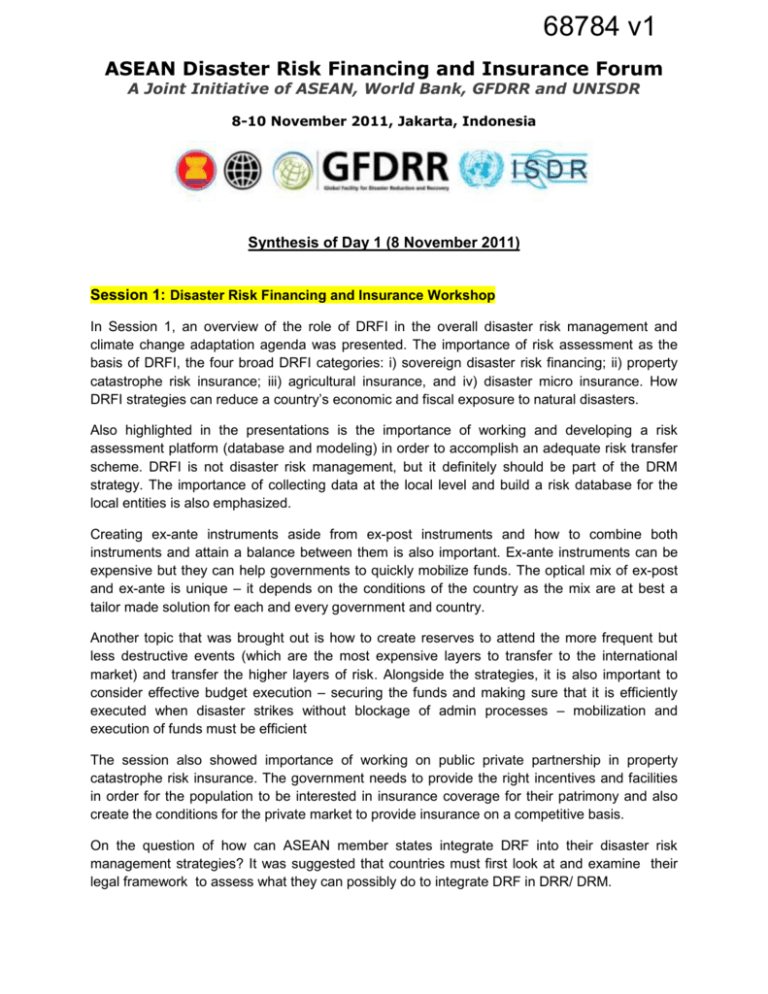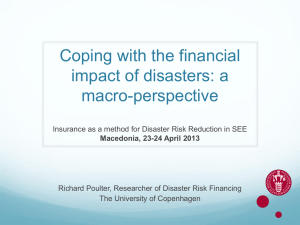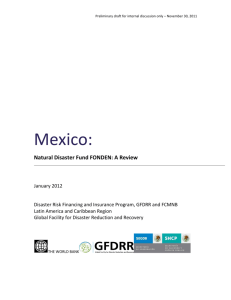ASEAN Disaster Risk Financing and Insurance Forum
advertisement

68784 v1 ASEAN Disaster Risk Financing and Insurance Forum A Joint Initiative of ASEAN, World Bank, GFDRR and UNISDR 8-10 November 2011, Jakarta, Indonesia Synthesis of Day 1 (8 November 2011) Session 1: Disaster Risk Financing and Insurance Workshop In Session 1, an overview of the role of DRFI in the overall disaster risk management and climate change adaptation agenda was presented. The importance of risk assessment as the basis of DRFI, the four broad DRFI categories: i) sovereign disaster risk financing; ii) property catastrophe risk insurance; iii) agricultural insurance, and iv) disaster micro insurance. How DRFI strategies can reduce a country’s economic and fiscal exposure to natural disasters. Also highlighted in the presentations is the importance of working and developing a risk assessment platform (database and modeling) in order to accomplish an adequate risk transfer scheme. DRFI is not disaster risk management, but it definitely should be part of the DRM strategy. The importance of collecting data at the local level and build a risk database for the local entities is also emphasized. Creating ex-ante instruments aside from ex-post instruments and how to combine both instruments and attain a balance between them is also important. Ex-ante instruments can be expensive but they can help governments to quickly mobilize funds. The optical mix of ex-post and ex-ante is unique – it depends on the conditions of the country as the mix are at best a tailor made solution for each and every government and country. Another topic that was brought out is how to create reserves to attend the more frequent but less destructive events (which are the most expensive layers to transfer to the international market) and transfer the higher layers of risk. Alongside the strategies, it is also important to consider effective budget execution – securing the funds and making sure that it is efficiently executed when disaster strikes without blockage of admin processes – mobilization and execution of funds must be efficient The session also showed importance of working on public private partnership in property catastrophe risk insurance. The government needs to provide the right incentives and facilities in order for the population to be interested in insurance coverage for their patrimony and also create the conditions for the private market to provide insurance on a competitive basis. On the question of how can ASEAN member states integrate DRF into their disaster risk management strategies? It was suggested that countries must first look at and examine their legal framework to assess what they can possibly do to integrate DRF in DRR/ DRM. Session 2: Country Case Studies: Disaster Risk Financing and Insurance Programs In Session 2 we looked at various case studies and experiences of Indonesia, Philippines, Mexico (Fonden), and the Caribbean Catastrophe Risk Insurance Facility. In Indonesia, DRF is a work in process. The sources of disaster management funds come from the central government or state budget, regional government's budget and public participation through contributions from NGOs and general public. The Philippines new legal framework, the Philippine Disaster Risk Management Act of 2010, has shifted the focus from post-disaster rehabilitation and reconstruction to ex-ante interventions, including mandating the development of appropriate risk transfer mechanisms. It has revamped the National and Local Calamity funds to finance ex-ante disaster risk preparedness and mitigation activities. The country is now starting to craft a national DRF strategy. In Mexico, the government created a fund for natural disasters — FONDEN — to which it transfers budgetary funds for disaster relief and reconstruction efforts. In addition, Mexico developed an institutional framework for disaster preparedness involving risk assessment, risk reduction, the promotion of a culture of prevention, and insurance. With these initiatives, Mexico moved from an ex-post response to natural disasters to an ex-ante preparedness approach. FONDEN uses various instruments to support local states and entities in responding to natural disasters, including reserve funds and risk transfer solutions and tools. The Caribbean Catastrophe Risk Insurance Facility aims to provide its members with access to affordable and effective coverage against natural disasters. CCRIF enables countries to pool their individual risks into a single, better diversified joint reserve mechanism. Through risk pooling, CCRIF provides coverage to countries at a significantly lower cost than individual governments would incur if they had to maintain their own reserves or if they were to independently purchase insurance in the open market. Highlights of the discussion: In risk pooling, countries pay for the risk they face and not the risk of others. Working together, all countries can still benefit because risk pooling lowers the capital to maintain the fund, thus lowering the premium. Strong political momentum, strong ownership and commitment by governments are required to make it work. One benefit of risk financing is that it is a way to price risk, which is needed to conduct a cost benefit analysis in investing in DRR. This has significance to considering a parametric scheme where the payout depends on the intensity of the disaster event, not on the value damage. Strengthening DRR will lower losses for country but allows the same payout. Risk transfer allows for a quick access to a large amount of money after a disaster, while loans will have to be repaid. The cost of stopping some investments to repay loans must be compared to the cost of buying insurance. Line of credit can be combined with risk transfer to respond to individual needs of countries All countries signified that they have a government budget allocated for covering disaster losses and for response activities, and has agreed on the importance of exploring DRF options on a national or regional basis. However few countries emphasized the need also to assess national DRF schemes and strengthen it before moving towards a regional scheme. The convening of the three sectors in the forum is a good opportunity to initiate the dialogue for inter-sectoral cooperation at finding appropriate DRF solutions and strategies.









